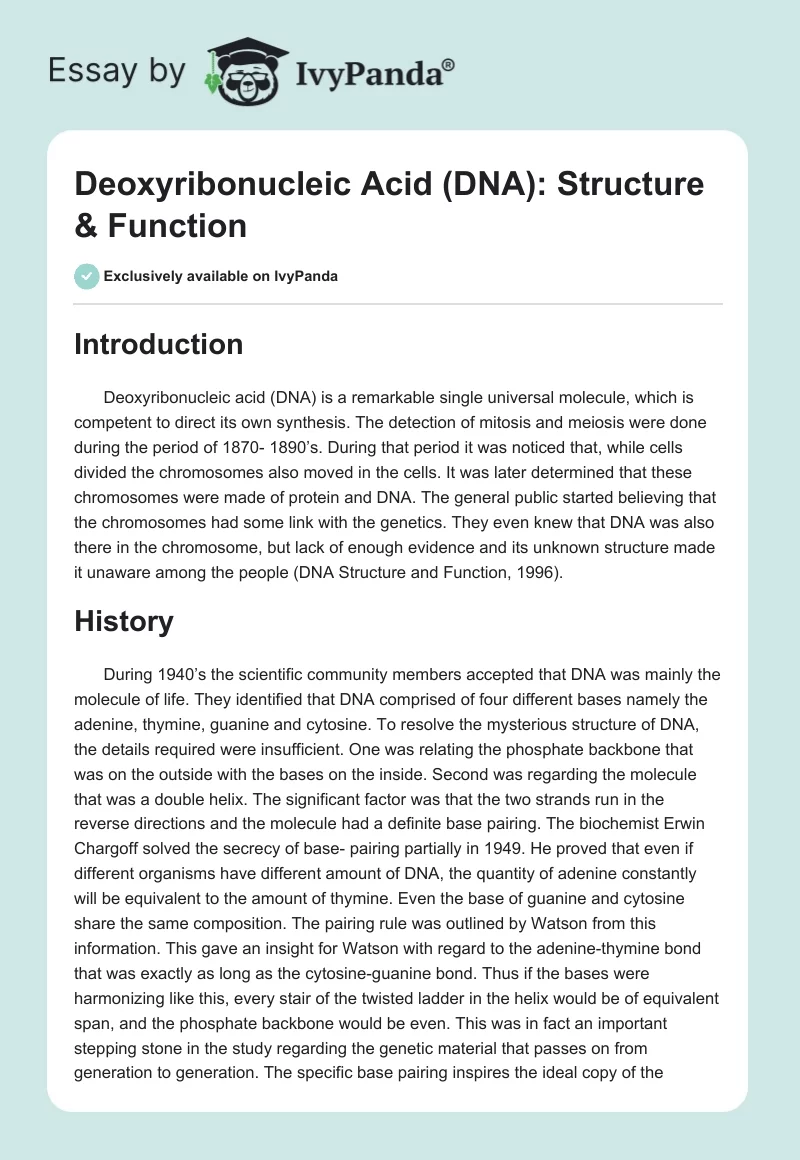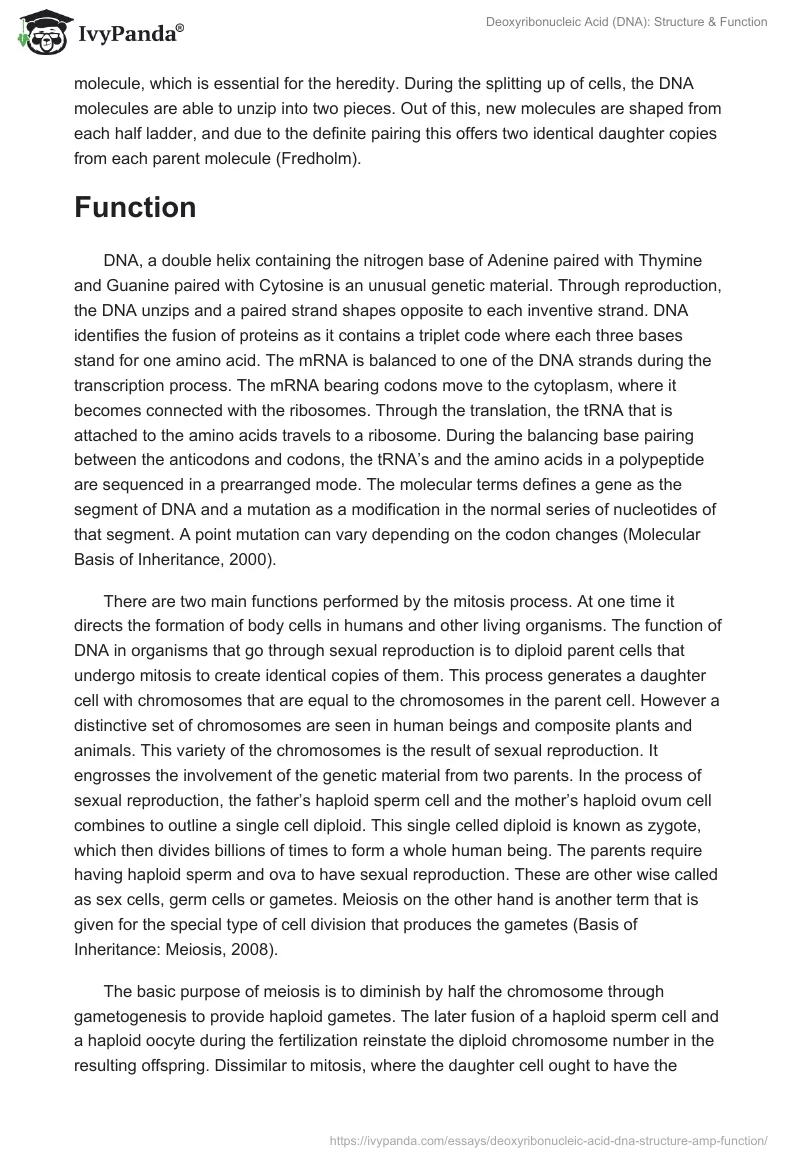Introduction
Deoxyribonucleic acid (DNA) is a remarkable single universal molecule, which is competent to direct its own synthesis. The detection of mitosis and meiosis were done during the period of 1870- 1890’s. During that period it was noticed that, while cells divided the chromosomes also moved in the cells. It was later determined that these chromosomes were made of protein and DNA. The general public started believing that the chromosomes had some link with the genetics. They even knew that DNA was also there in the chromosome, but lack of enough evidence and its unknown structure made it unaware among the people (DNA Structure and Function, 1996).
History
During 1940’s the scientific community members accepted that DNA was mainly the molecule of life. They identified that DNA comprised of four different bases namely the adenine, thymine, guanine and cytosine. To resolve the mysterious structure of DNA, the details required were insufficient. One was relating the phosphate backbone that was on the outside with the bases on the inside. Second was regarding the molecule that was a double helix. The significant factor was that the two strands run in the reverse directions and the molecule had a definite base pairing. The biochemist Erwin Chargoff solved the secrecy of base- pairing partially in 1949. He proved that even if different organisms have different amount of DNA, the quantity of adenine constantly will be equivalent to the amount of thymine. Even the base of guanine and cytosine share the same composition. The pairing rule was outlined by Watson from this information. This gave an insight for Watson with regard to the adenine-thymine bond that was exactly as long as the cytosine-guanine bond. Thus if the bases were harmonizing like this, every stair of the twisted ladder in the helix would be of equivalent span, and the phosphate backbone would be even. This was in fact an important stepping stone in the study regarding the genetic material that passes on from generation to generation. The specific base pairing inspires the ideal copy of the molecule, which is essential for the heredity. During the splitting up of cells, the DNA molecules are able to unzip into two pieces. Out of this, new molecules are shaped from each half ladder, and due to the definite pairing this offers two identical daughter copies from each parent molecule (Fredholm).
Function
DNA, a double helix containing the nitrogen base of Adenine paired with Thymine and Guanine paired with Cytosine is an unusual genetic material. Through reproduction, the DNA unzips and a paired strand shapes opposite to each inventive strand. DNA identifies the fusion of proteins as it contains a triplet code where each three bases stand for one amino acid. The mRNA is balanced to one of the DNA strands during the transcription process. The mRNA bearing codons move to the cytoplasm, where it becomes connected with the ribosomes. Through the translation, the tRNA that is attached to the amino acids travels to a ribosome. During the balancing base pairing between the anticodons and codons, the tRNA’s and the amino acids in a polypeptide are sequenced in a prearranged mode. The molecular terms defines a gene as the segment of DNA and a mutation as a modification in the normal series of nucleotides of that segment. A point mutation can vary depending on the codon changes (Molecular Basis of Inheritance, 2000).
There are two main functions performed by the mitosis process. At one time it directs the formation of body cells in humans and other living organisms. The function of DNA in organisms that go through sexual reproduction is to diploid parent cells that undergo mitosis to create identical copies of them. This process generates a daughter cell with chromosomes that are equal to the chromosomes in the parent cell. However a distinctive set of chromosomes are seen in human beings and composite plants and animals. This variety of the chromosomes is the result of sexual reproduction. It engrosses the involvement of the genetic material from two parents. In the process of sexual reproduction, the father’s haploid sperm cell and the mother’s haploid ovum cell combines to outline a single cell diploid. This single celled diploid is known as zygote, which then divides billions of times to form a whole human being. The parents require having haploid sperm and ova to have sexual reproduction. These are other wise called as sex cells, germ cells or gametes. Meiosis on the other hand is another term that is given for the special type of cell division that produces the gametes (Basis of Inheritance: Meiosis, 2008).
The basic purpose of meiosis is to diminish by half the chromosome through gametogenesis to provide haploid gametes. The later fusion of a haploid sperm cell and a haploid oocyte during the fertilization reinstate the diploid chromosome number in the resulting offspring. Dissimilar to mitosis, where the daughter cell ought to have the similar genetic component as that of the parent cell from which they are originated, the meiosis serves to efficiently mix up the genetic matter in two ways. This process generates an almost infinite genetic diversity from the starting parental chromosomes. The meiotic procedure engrosses two cell divisions and is accordingly divided in to two parts namely meiosis I and meiosis II. At the same time as in mitosis these divisions are sub divided in to the stages Prophase, Metaphase, Anaphase and Telophase, whereby a full meiotic procedure involves two of each of the stages (Hultén).
Gregor Mendel has developed three basic principles that formed the foundation for the new science of genetics. He noticed that self pollinating pea plants in the garden were true breeding, which produced offspring with characteristics identical to their own. He also noticed seven different characteristics that reflected in all of the plants. By centralizing only one trait at a time he cross pollinated plants with each of the seven distinct traits and examined their off springs. The result indicated that nearly one fourth of one set of plans showed recessive features while three fourths showed dominant traits of their parents. The result was a consistent 3:1 ratio between dominant and recessive offspring. Mendel brought out a revolutionary detail to this experiment. He said that within a person hereditary information was included in paired units with each unit taking its origin from each parent. In the experiment using plants Mendel also noticed that the outcome can be further explained if the paired units are divided at random allow the gamete to contain only a single of the two units. The theory was later called law of segregation (Mendel’s Experiments, 2008).
References
- Basis of Inheritance: Meiosis 2008. Web.
- DNA Structure and Function 1996.
- Fredholm, L.The Discovery of the Molecular Structure of DNA – The Double Helix.
- Hultén, M. Chromosome Behaviour at Meiotic Cell Divisions. 2008.
- Mendel’s Experiments 2008. Web.
- Molecular Basis of Inheritance 2000. Web.


